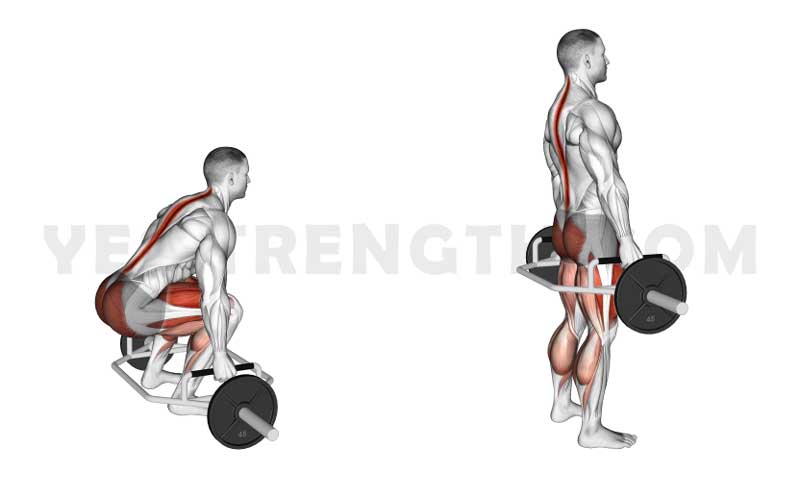The trap bar deadlift, also known as the hex bar deadlift, is a popular exercise in the world of strength training and weightlifting. It offers a unique variation to the traditional barbell deadlift, providing several advantages and making it an attractive option for both beginners and seasoned lifters. Many people consider it to be an easier version of deadlift. Is it true or false? Let’s explore why the trap bar deadlift is considered easier compared to other deadlift variations and why it has gained popularity among fitness enthusiasts.
Reasons that make Trap Bar Deadlift Easier
1) Positioning of Trap Bar Makes it Easier
The trap bar deadlift involves lifting a loaded hexagonal-shaped barbell from the ground while standing inside the bar.
Unlike the conventional barbell deadlift, where the lifter stands behind the bar, the trap bar deadlift allows for a more centered and balanced position.
This positioning makes it easier to maintain proper form and execute the movement with precision.
2) Ergonomic Grip of the Trap Bar Makes it Easier
The mechanics of the trap bar deadlift contribute to its ease and effectiveness. By standing within the bar, the lifter’s center of gravity is aligned with the barbell, minimizing unnecessary strain on the lower back and providing better stability.
The design of the trap bar also allows for a more natural and ergonomic grip, which reduces the risk of grip fatigue during heavier lifts.
Benefits of the Trap Bar Deadlift
The trap bar deadlift offers several benefits that make it an attractive exercise option for individuals of varying fitness levels. Let’s explore some of these benefits in detail:
1) Reduced Stress on the Lower Back
One of the primary advantages of the deadlifts with trap bar is its ability to reduce stress on the lower back.
The more upright torso position achieved with the trap bar deadlift decreases the sheer forces exerted on the lumbar spine, making it a safer alternative for individuals with lower back issues.
2) Enhanced Quadriceps Engagement
Deadlifting with trap bar places a greater emphasis on the quadriceps compared to deadlifts with barbell.
The more upright position and the mechanics of the lift require increased quadriceps activation, making it a valuable exercise for individuals aiming to target and strengthen their quadriceps muscles.
3) Improved Grip Strength
The trap bar’s design with handles at the sides allows for a neutral grip, which is easier to maintain and less stressful on the wrists compared to an overhand or mixed grip used in traditional deadlifts.
This improved grip position enables individuals to lift heavier loads and work on their grip strength without compromising safety.
4) Versatility and Variations
Trap bar deadlifts offers great versatility in terms of exercise variations. It can be modified by adding chains, resistance bands, or using different grip widths to target specific muscle groups and increase the challenge as per individual preferences and training goals.
Drawbacks of Trap Bar Deadlift
1) Reduced posterior chain activation
Compared to the conventional barbell deadlift, the trap bar deadlift may result in slightly less activation of the posterior chain muscles, such as the hamstrings and glutes.
This is due to the more upright torso position and altered mechanics of the lift. If your primary goal is specifically targeting these muscles, other deadlift variations might be more suitable.
2) Limited skill transfer
Although the trap bar deadlift shares some similarities with the conventional deadlift, the technique and movement patterns are not identical.
This means that the strength and skill developed in the trap bar deadlift may not directly transfer to other deadlift variations or exercises.
If you have specific goals that involve mastering other deadlift variations, it’s important to incorporate them into your training routine as well.
3) Less emphasis on grip strength
While the trap bar deadlift still requires grip strength, the neutral grip position provided by the handles of the trap bar can make it slightly easier to maintain a secure grip compared to other deadlift variations. If you’re specifically targeting grip strength development, incorporating exercises that place greater demand on grip, such as barbell deadlifts with an overhand or mixed grip, may be necessary.
4) Limited range of motion for some individuals
The design of the trap bar may limit the range of motion for individuals with mobility restrictions or those who have longer legs and struggle to maintain proper form within the confines of the bar.
In such cases, it’s important to assess your personal limitations and make adjustments or seek alternative exercises that allow for a full range of motion.
5) Equipment availability
While the trap bar has gained popularity, it may not be as readily available in all gyms or training facilities.
If you do not have access to a trap bar, it can be challenging to perform trap bar deadlifts and enjoy their benefits. In such cases, exploring other deadlift variations or working with available equipment options becomes necessary.
Pros And Cons of Trap Bar Deadlifts
| Pros | Cons |
| Offers a more centered and balanced position | Reduced posterior chain activation compared to conventional deadlifts |
| Reduces stress on the lower back | Limited skill transfer to other deadlift variations |
| Provides enhanced quadriceps engagement | Less emphasis on grip strength |
| Improves grip strength | Limited range of motion for some individuals |
| Allows for versatility and exercise variations | Availability of trap bars in some gyms or training facilities may be limited |
Training for Explosiveness and Power

In addition to its ease and versatility, deadlifting with trap bar is an excellent exercise for developing explosiveness and power.
The more centered positioning and improved leverage make it easier to generate force and achieve a powerful extension of the hips and knees during the lift.
This also makes it beneficial in generating more power and hence helping you to lift heavier weight, which wouldn’t have been possible on conventional deadlift for some people.
This explosive movement is beneficial for athletes involved in sports that require quick bursts of strength, such as sprinting, jumping, and throwing.
Common Mistakes to Avoid
While the trap bar deadlift is generally considered easier, there are still some common mistakes that lifters should avoid to maximize its benefits and prevent injuries. Some of these mistakes include:
1) Rounding the back
Maintaining a neutral spine throughout the lift is crucial to prevent lower back injuries. Avoid rounding or excessively arching the back during the movement.
This is one of the most common mistakes people make. Take your time to learn and perfect the form and then try to increase your weight.
2) Using too much weight
It’s important to start with manageable weights and gradually progress. Using excessive weight can compromise form and increase the risk of injury.
With good form you can lift even heavier without getting in trouble. Better to correct the form and get used to it rather than increasing weight too early.
3) Neglecting proper hip and knee alignment
Ensure that your knees and hips are properly aligned and tracking over the toes throughout the lift. Improper alignment can lead to undue stress on the joints.
Tips for Proper Form and Technique
To perform deadlifts with trap bar with proper form and technique, consider the following tips:
- Begin by standing in the center of the trap bar with feet shoulder-width apart.
- Maintain a neutral spine and engage the core.
- Bend at the hips and knees, ensuring your shins touch the bar.
- Grip the handles with a firm grip and maintain a neutral wrist position.
- Drive through the heels, extend the hips and knees simultaneously, and lift the bar.
- Keep the bar close to your body throughout the lift.
- Maintain a controlled descent when lowering the bar back to the ground.
Tips to make Trap Bar Deadlift more challenging
To make the trap bar deadlift more challenging and continue progressing in your strength and fitness journey, you can implement several strategies. Here are some effective ways to increase the difficulty of the trap bar deadlift:
1) Increase the weight
Gradually add more weight to the trap bar. This will increase the resistance and force your muscles to work harder to lift the heavier load. Start by incrementally increasing the weight in manageable increments as you build strength and confidence.
2) Focus on tempo of trap bar deadlift
Incorporate tempo variations into your trap bar deadlifts. Slow down the lowering phase (eccentric) of the lift and control the movement, then explode with power during the lifting phase (concentric). This deliberate control and emphasis on tempo will increase time under tension and challenge your muscles further.
3) Use single-leg variations
Perform single-leg trap bar deadlifts to challenge your stability and balance. This exercise places more demand on each leg individually, forcing your muscles to work harder to maintain control and stability throughout the movement. Start with lighter weights and gradually progress as you master the technique.
4) Try deficit trap bar deadlifts
Perform trap bar deadlifts standing on a slightly elevated surface, such as weight plates or a small platform. This increased range of motion will further engage your muscles, particularly your hamstrings and glutes, making the exercise more challenging.
5) Incorporate pauses
Add pauses at different points during the trap bar deadlift. For example, pause for a few seconds just above the ground, mid-shin, or at the top of the lift. These pauses increase time under tension, enhance muscle activation, and require more strength to overcome the inertia when initiating the lift again.
6) Perform high-rep sets
Instead of focusing solely on heavyweights, incorporate higher repetition ranges. Performing sets with 12-15 or more repetitions can challenge your muscular endurance and cardiovascular system, creating a different kind of intensity and promoting overall strength and conditioning.
7) Utilize unilateral movements
Incorporate unilateral variations, such as single-arm trap bar deadlifts or staggered stance trap bar deadlifts. These movements require greater stability and coordination while increasing the demand on specific muscle groups.
How to Incorporate Trap Bar Deadlift into Your Training Routine
To incorporate the trap bar deadlift into your training routine, consider the following guidelines:
- Start with a warm-up: Perform dynamic stretches and mobility exercises to prepare your muscles and joints for the workout.
- Begin with lighter weights: Focus on mastering the technique before progressively increasing the load.
- Perform 3-4 sets of 8-12 repetitions: Adjust the weight and repetitions based on your goals and fitness level.
- Allow for adequate rest between sets: Rest for 1-2 minutes between each set to maintain proper form and maximize performance.
Frequently Asked Questions (FAQs)
1) Is the trap bar deadlift suitable for beginners?
Yes, the trap bar deadlift is more suitable for beginners as it offers a more stable and centered lifting position, reducing the risk of injury.
2) Can trap bar deadlifts replace traditional deadlifts?
While the trap bar deadlift offers unique benefits, it cannot replace the traditional deadlift. Both exercises have their advantages and can be incorporated into a well-rounded training program.
3) Can the deadlifting with trap bar help in building muscle mass?
Yes, the trap bar deadlift is an effective exercise for building muscle mass, particularly in the lower body. It targets multiple muscle groups, including the quadriceps, hamstrings, glutes, and calves.
4) Should I use lifting straps to do trap bar deadlifts?
It is generally recommended to avoid using lifting straps for the trap bar deadlift. The exercise helps improve grip strength, and using straps can hinder that progress.
5) Can the trap bar deadlift be used for rehabilitation purposes?
The trap bar deadlift can be a suitable option for individuals undergoing rehabilitation, as it places less stress on the lower back compared to other deadlift variations. However, it is crucial to consult with a healthcare professional or a qualified trainer for personalized guidance.
Conclusion
The trap bar deadlift offers an easier yet effective alternative to traditional barbell deadlift variations. Its unique design and mechanics provide benefits such as reduced stress on the lower back, enhanced quadriceps engagement, improved grip strength, and versatility in training.
By incorporating the trap bar deadlift into your workout routine and following proper form and technique, you can experience its advantages and take your strength and fitness to new heights.





